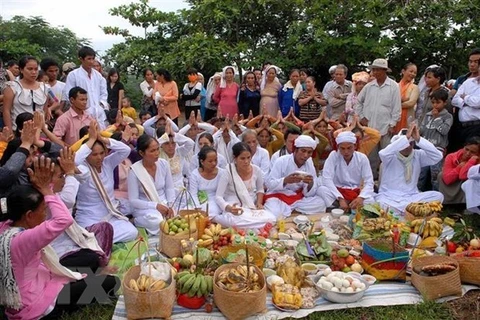 Products of the Bau Truc pottery village of the Cham ethnic people in Ninh Phuoc district, south central Ninh Thuan province (Photo: VNA)
Products of the Bau Truc pottery village of the Cham ethnic people in Ninh Phuoc district, south central Ninh Thuan province (Photo: VNA)Hanoi (VNA) - The inscription of the art of pottery making of the Cham people on UNESCO's list of intangible cultural heritage in need of urgent safeguarding will promote measures to preserve the heritage, create more sources for the preservation and promotion of the heritage’s value, and support economic and cultural development toward sustainability and inclusiveness in localities and residential communities.
Inscribing Vietnam’s first craft
The art of pottery making of Cham ethnic people was inscribed on the UNESCO list of intangible cultural heritage in need of urgent safeguarding on November 29.
The recognition was made at the 17th session of the Inter-governmental Committee for the Safeguarding of the Intangible Cultural Heritage in Rabat, Morocco, according to the Ministry of Culture, Sports and Tourism.
Addressing the announcement ceremony, Le Thi Thu Hien, Director of the Department of Cultural Heritage, affirmed that the government and especially the Cham community in Vietnam are committed to doing their best to protect this precious heritage.
 The Chairman of the 17th session of the Inter-governmental Committee for the Safeguarding of the Intangible Cultural Heritage hammers to recognise the art of pottery making of Cham ethnic people as the intangible cultural heritage in need of urgent safeguarding. (Photo: VNA)
The Chairman of the 17th session of the Inter-governmental Committee for the Safeguarding of the Intangible Cultural Heritage hammers to recognise the art of pottery making of Cham ethnic people as the intangible cultural heritage in need of urgent safeguarding. (Photo: VNA)Ambassador Le Thi Hong Van, Chief Representative of the Vietnamese Delegation to UNESCO, said that the art of pottery making of Cham ethnic people is Vietnam’s 15th intangible cultural heritage to be named on UNESCO lists.
The recognition once again affirms the international community's appreciation for the cultural values of Vietnamese people, thereby contributing to introducing international friends the unique cultural heritage of the south central coast, Van said, adding that this also shows responsible contributions of Vietnam, a member of the Intergovernmental Committee for Safeguarding of the Intangible Cultural Heritage in the 2022-226 tenure, to the goal of preserving and promoting the heritage values that UNESCO is promoting.
With UNESCO’s recognition, people of Ninh Thuan and Binh Thuan provinces will be better aware of the value of the art of pottery making of Cham ethnic people.
Cham pottery - Unique handmade product
The art of pottery making of Cham ethnic people plays a great role in the economic, cultural and social life. Pottery products are indispensable in the daily life and activities of each family and in the religious culture of the Cham community.
 Bau Truc pottery products (Phuoc Dan township, Ninh Phuoc district, south central province of Ninh Thuan) (Photo: VNA)
Bau Truc pottery products (Phuoc Dan township, Ninh Phuoc district, south central province of Ninh Thuan) (Photo: VNA)Cham pottery products are mainly household utensils, worship objects, and handicrafts such as jars (called “jek”), pots (gok), food trays (cambak), and vases (bilaok).
Pottery making is considered a demonstration of Cham women’s creativity on the basis of their community’s knowledge.
Notably, instead of using turntables, Cham women move themselves backward around blocks of clay to shape objects. The products are not laid with enamel but dried and baked outdoor in wood and rice straw fires at about 800 degrees Celsius for seven - eight hours.
Clay is sourced from the Hamu Tanu Halan field on the banks of the Quao River in Bau Truc village and the clay pit of Xuan Quang village, about 3km to the northwest of Binh Duc village, the south central province of Ninh Thuan.
Efforts to preserve Cham pottery
Established around 800 years ago by the ethnic Cham people, the Bau Truc Pottery Village is one of the oldest craft villages of its kind in Southeast Asia.
The village, which has existed since the reign of King Po Klong Garai (1151-1205) of the Champa Kingdom, holds a ceremony every year to honour Po Klong Chan, its founder.
Today, it stands as a historic, cultural, and artistic landmark in Ninh Thuan province.
For many centuries, Cham people in Bau Truc village have been maintaining their traditional craft with skills and techniques handed down through successive generations. Therefore, this place is called the "living museum" of Cham pottery by researchers and domestic and foreign tourists.
Despite its long history, the pottery making is still at risk of disintegration due to the urbanisation process’s impact on the access to raw materials, the slow adaptation to the market economy, and young people’s lack of interest in the craft.
In response, the village’s artisans have begun creating new types of products with high aesthetic value, including decorative ones and souvenirs for tourists.
The artisans have also improved the design and quality of products that combine characteristics of western and Vietnamese culture in Cham pottery.
In addition, the village has worked to promote pottery products along with community-based development. Community-based tourism have helped locals improve livelihoods while contributing to protect the environment and native cultural values.
Within the framework of the project on developing community-based tourism on heritage in Bau Truc village, carried out by the British Council in collaboration with the Department of Culture, Sports and Tourism of Ninh Thuan province, villagers have provided with guidance, training to welcome tourists, introduce products, teach tourists how to make cakes and traditional dishes of Cham people./.
























